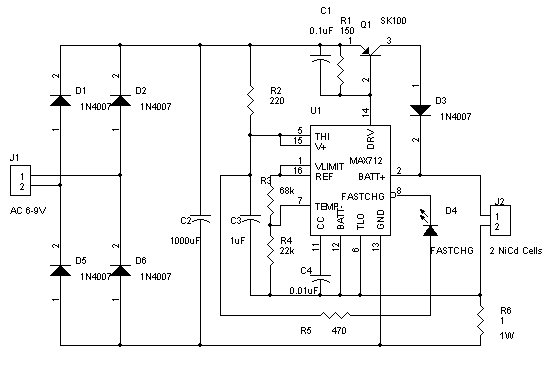NiCd Battery Fast Charger
This is an advanced battery charger design based on
Maxim's battery charger IC MAX712. This device can, using a minimal set of external components, fast-charge an NiCd/NiMH rechargeable battery. Fast charge is terminated using several detection methods, including ΔV/Δt, ΔT/Δt and a time-based cutout. Full details can be obtained from the MAX712 datasheet, available at the
Maxim Inc. WebsiteOverview
This circuit is from the MAX712 Datasheet, and makes use of the ΔV/Δt and timeout methods to terminate Fast Charging. It is designed to charge two NiCd pencil (AA) batteries, at 300mA. After fastcharge is completed, Trickle charging begins, at 15mA.
Design equations for various circuit elements in the standard application circuits are given in the MAX712 datasheet. These have been used to calculate the values for various components. The indicated power transistor is a 2N6109, which was not available locally. I used an SK100 transistor instead. It works fine, except that since it is in a TO-92 metal-can case, heatsinking is inadequate for supply voltages higher than around 7V.

NiCd Battery Fast Charger
Construction of the circuit posed few problems, except for high-frequency oscillations observed on the power lines. This was before I had constructed the bridge rectifier stage, and was drawing power from a bench supply through a long wire. It proved very difficult to kill these oscillations (at 1MHz), but a few 0.1μF capacitors did the trick. This is mentioned in case you build the charger without a built-in rectifier. AC power is obtained from a modem power supply transformer. The whole circuit was assembled onto veroboard. Connectors for the AC jack were inserted after cutting three holes in the circuit board, and using large amounts of solder to hold it in place.
Improvements: The MAX712 datasheet describes how one can use a thermistor to implement thermal fastcharge cutoff, and also how to make a switching version of the charger. This requires more parts, but has a substantial reduction in power dissipation.
Disclaimer
These circuits are provided for your own study only. They all deal with electricity and electronics, a sufficient knowledge of both is assumed. I will not take any responsibility for any personal injury or damage to property arising from use or abuse of the information provided on these pages.
